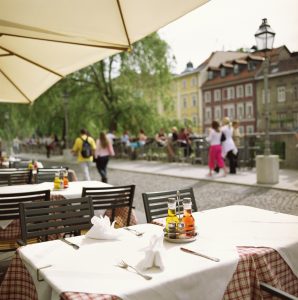 As the COVID-19 pandemic continues to ravage the U.S. economy, restaurateurs and bar owners are feeling the brunt of business closures and adaptations necessary to combat the disease. Where cozy and intimate dining was once de rigueur for the restaurant industry, these businesses must now shift to outdoor dining with adequate space and airflow between parties. In response to these concerns, many cities across the country who once fought against the loss of any parking have turned to a post-automobile tactic: outdoor dining in thoroughfares and parking lots. While at first glance it might seem a simple enough prospect—throw some chairs and a table out front, and voilà—property owners and restaurateurs must remain cognizant of various liability and regulatory hurdles for operating outside.
As the COVID-19 pandemic continues to ravage the U.S. economy, restaurateurs and bar owners are feeling the brunt of business closures and adaptations necessary to combat the disease. Where cozy and intimate dining was once de rigueur for the restaurant industry, these businesses must now shift to outdoor dining with adequate space and airflow between parties. In response to these concerns, many cities across the country who once fought against the loss of any parking have turned to a post-automobile tactic: outdoor dining in thoroughfares and parking lots. While at first glance it might seem a simple enough prospect—throw some chairs and a table out front, and voilà—property owners and restaurateurs must remain cognizant of various liability and regulatory hurdles for operating outside.
With Great Space Comes Great … Potential Liability.
One of the largest concerns for landowners in operating in a new space for business is liability. Who is on the hook if someone gets hurt dining in an impromptu dining space in a parking lot? Prior to beginning new outdoor dining operations, landowners and restaurateurs should contact their insurance providers to ensure that the new space is included in their insurance coverage. This is a particular concern for larger commercial landowners who may have various businesses vying to use their parking lot for business. Many leases have carefully crafted clauses limiting where a business may operate and where their liability ceases. Landowners and business owners should review their leases for any such clauses and negotiate with one another to ensure that liability in these new spaces is clearly defined.
Insurance coverage aside, landowners and restaurateurs must also be cognizant of their duties under the Americans with Disabilities Act (ADA), which has strict accessibility requirements that still apply to businesses during the pandemic. As such, business owners must ensure that any temporary outdoor dining space is still accessible to customers, whether that requires building ramps to the dining area or ensuring enough space between tables to comply with both social-distancing requirements and ADA wheelchair clearance requirements.
What Exactly Do Your Permits Permit?
As any restaurateur or landowner knows, it is vital to check what uses are permitted on your property and what permits might be necessary to change any such operation. This is even more important during the pandemic, as cities and states threaten fines for non-compliant business operation. These questions can range from the simple, “Does my alcoholic beverage permit allow outdoor service?” to the nit-picky, “what is the maximum height for my impromptu barriers between tables?” Many jurisdictions have relaxed the rules surrounding outdoor dining; however, landowners should be sure to doublecheck any guidance released by local and state governments to ensure they are not at risk of fines or closure.
Beyond basic permits, landowners must be cognizant of where their city even allows outdoor dining. Some cities, such as New York City, only require permits for use of public sidewalks or streets for dining and give broad discretion for dining on private property. Other cities, such as Oakland, still require landowners to go through fast-tracked permitting for outdoor dining even on private property to ensure compliance with county and state social-distancing guidelines.
Ultimately, the COVID-19 pandemic has given new meaning to the phrase “things are more complicated than they appear.” For business owners, that means it’s more important than ever to stop and consider liability and regulatory challenges for even the simplest of solutions.
 Gravel2Gavel Construction & Real Estate Law Blog
Gravel2Gavel Construction & Real Estate Law Blog


